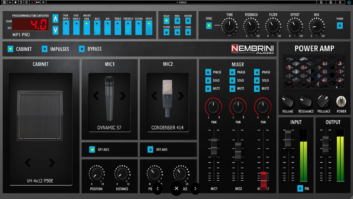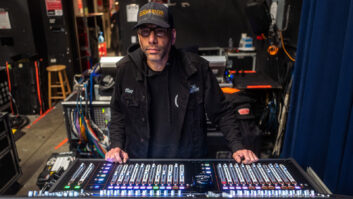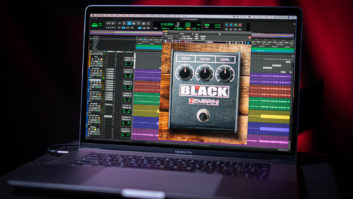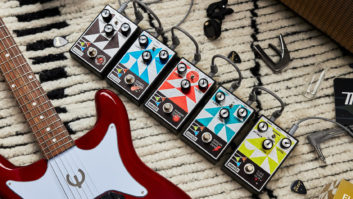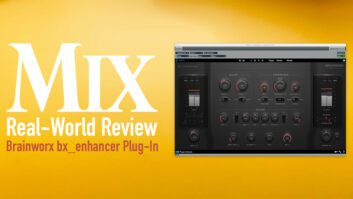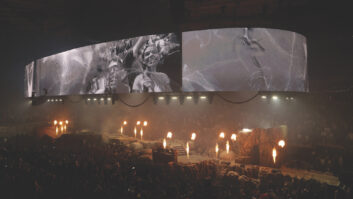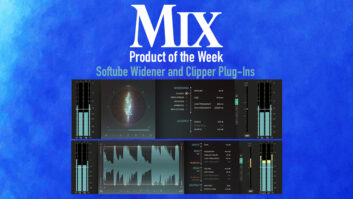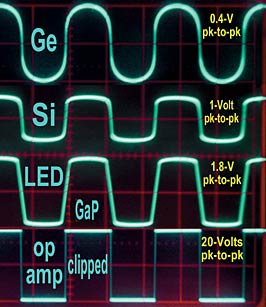
If you have ever felt that guitars are bullying the vocals and the drums, then it’s time to take a closer look at those subtly subversive guitar multi-effects processors, now available in all forms — analog, digital and DSP/emulation, as well as hybrid variations.
Figure 1: Three examples of diode clipping plus hard clipping
Distortion is a regular guest here on the geek-ville road show, particularly the nonlinear transition from clean to hard clipping. When it comes to guitar sounds, this is where the action is. Sometimes the transition is a broad window; other times, it’s very narrow. Let’s call any circuit with a transition window a “soft stage” for simplicity. The goal is to optimize the gain structure to make the most of the window’s sweet spot. That’s not an easy task with the majority of MI gear on the market, where on a good day, “metering” is a single LED.
Here’s where psychology comes in. We all rely on our ears, but we must also learn to differentiate loud from good. Plus, what seems “right” on its own may not “play well with others.” Any type of processing that gets us in the ballpark is cool and powerful. For example, it’s easy to create a perfectly smooth, instant solo guitar tone, but multiple layers of similarly processed guitars can quickly take up valuable real estate.
THE COOKBOOK
This month’s column has a three-way focus: the order in which stomp boxes and signal processors are placed in the signal path; the art (and science) of choosing tubes; and the relationship between the power amp and the loudspeaker. Think of the source and destination as the bread, with the primary signal topology (preamp and amp) as the protein. In between, the stomp boxes, tubes, transistors, diodes and impedance relationships are the sonic condiments.
Let’s work our way backward from the most-aggressive to least-aggressive types of distortion. Fuzz boxes typically use diodes to soft-clip the signal. To further increase aggression and sustain, the diode’s drive amp gain is increased until it hard-clips. This is the narrowest window, where the dynamics have been completely flat-lined.
Aficionados of diodes are aware of the variations, such as germanium (Ge), silicon (Si) and gallium phosphide (GaP); aka LEDs. These produce a clipping range of 0.3, 0.6 or 1.2 volts, respectively — narrow windows to be sure — each with its own version of what “soft” is. EQ networks focus the distortion in a specific frequency range and attempt to recover lost warmth. Figure 1 shows three examples of diode clipping, as well as hard clipping.
SPAGHETTI BENDERS
You have little choice but to put a fuzz box in between an instrument and an amp; doing so undermines any subtle contribution that the tubes downstream might make, which is fine unless you are looking for something less black and white. I find it interesting to see compression applied to an already smashed guitar track.
However, if a compressor is placed before any soft stage — from fuzz box to analog tape — the drive (output) level can then be optimized for the window’s sweet spot. Similar to fuzz boxes but in a more genteel way, Neve’s 2254 and 33609 compressor/limiters use diodes as the gain-control device — hard to believe.
To take advantage of the diode’s limited dynamic range, the signal must be considerably scaled down (attenuated), proof that the optimized window approach works. I’ll take a closer look at these classic dynamics processors this year. (Dolby and dbx noise reduction took a similar approach to solving analog tape noise, using compression to optimize the signal level and then expansion to restore the dynamics.)
HOT STUFFBR>We associate tubes with musically harmonic overtones, but that idea is over-simplified on many levels. Distortion is a static measurement and an audio signal is anything but — dynamic distortion is harder to measure than a steady-state tone. Think of an amplifier as being similar to a racecar: How fast and effortlessly does it go from no signal to full signal? Some circuits are smooth, fast and agile; others are hesitant, sluggish and slow. A static test is like being on a straightaway; the real dynamic test is off-roading.
Overdriving a vacuum tube power amp is next in the aggressive line. Push-pull power amps — the type found in nearly every amp of 15 watts or more — yield a balanced mix of even- (octave) and odd-harmonic distortion. The single-ended, Class-A Fender Champ and similar single-power tube designs generate more even-order harmonics than that from odd.
Those who like power amp distortion should know that overdrive quality is dependent on the load — the loudspeaker impedance. Some vacuum tube power amps have an impedance switch, while others just specify the range. By comparison, solid-state amps don’t really care about the load, so long as it’s within the design range.
A four-speaker cabinet can be wired in several ways to achieve different impedances. Assuming four identical 16-ohm speakers, if all are wired in parallel, then the total impedance will now be 4 ohms. More typical would be to wire two pairs in series and then parallel the pairs. The resulting impedance then remains 16 ohms.
The formula for calculating parallel impedance is 1/Ztotal = 1/Za + 1/Zb + 1/Z etc., where “Z” is the speaker impedance. You can convert each fraction to its decimal equivalent, but keep in mind that after adding, the result is 1/Ztotal — not the answer, but requiring an additional step to be inverted.

Figure 2: The green trace shows the effect of impedance under-loading; the violet trace shows over-loading.
In Fig. 2, the green trace represents a slightly overdriven Class-A guitar amp (a Groove Tubes Solo Single) with its output impedance set for 8 ohms but driving a 10-ohm load (under-loaded). When the impedance is set for 16 ohms and driving the same load, the violet trace shows how overloading the amp changes the distortion characteristic.
PRE FOR THEE
Similar to power amps, overdriving two daisy-chained preamp stages creates a more balanced mix of even and odd harmonics. Overdriving one stage at a time yields more even than odd harmonics. When not overdriven, the preamp stage’s sound is largely dependent on the tube type and the EQ network, also known as the tone stack. For example, the JJ Tubes/Groove Tubes version of the ECC83 (euro 12AX7) deserves the “warm” moniker. Under “clean guitar circuit” operation, it has twice the distortion (2 percent) as compared to other versions of this tube.
If your amp’s front end (preamp) is too aggressive, then try a tube with less gain. Tweed-era Gibson amps used the 12AY7/6072. These also tended to be less microphonic and less noisy. New old stock (NOS) versions of the 6072 have become rare and pricey because of their use in microphones. Both NOS 12AY7 and a new version of the 6072 by Electro-Harmonix are available for about $20.
TWEED AND TWEEN
Two tonal extremes are tweed-era guitar amps and that very ’80s critter known as the Roland Jazz Chorus. (The JC-120 is still in production.) The fundamental difference is not just that one amp has tubes and the other is solid-state, but also what the designers chose to do with those topologies.
The JC-120 has an op amp front end and a discrete transistor power amplifier — both are ultra-linear and good if you want squeaky-clean. The built-in, but not particularly desirable, overdrive circuit is too drastic of a contrast and not soft enough for this application.
Contrast that with a tweed-era guitar amp, early versions of which had no negative feedback in the power amp. Without feedback, frequency response and headroom are not “flat” at the spectral extremes. This simpler, vintage-style approach is much less linear — softer on the top end and warmer (more colored) in the low-mids and bottom. The lack of feedback allows the speaker to resonate in a way that complements the instrument.
Linearity is not an exclusive characteristic of solid-state; it’s a design approach that can also be applied to vacuum tubes. Design simplicity can soften any topology — tubes or transistors. The fewer the components, the better, and without feedback, that’s the key to opening the soft-overload window. The Hamptone JFET mic preamp/DI by Scott Hampton represents a modern example of this. I think it comes closest to emulating a vacuum tube.
DESSERT
Guitar effects are typically not subtle, and distortion is often the key ingredient. But listen to Led Zeppelin or Black Sabbath, and you’ll hear understated, under-distorted guitars and something else: space, that final frontier. But let’s not forget that creativity and technique transcend gear.
Eddie has been testing, grading and “fretting” over FETs for mics, preamps and instrument applications. Visit him at
www.tangible-technology.com.
